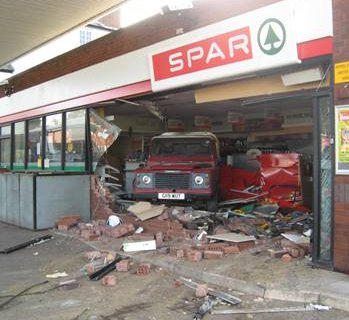Difference between revisions of "Security issue: Ram raid"
| Line 9: | Line 9: | ||
[[Image:ramraid.jpg|thumb|right|240px|Results of a ramraid]]This act has occurred since at least the mid 1930s. The term came into widespread use after a series of such raids in Belfast in 1979 that was covered in news reports and in countries such as Australia that inspired a series of similar crimes. |
[[Image:ramraid.jpg|thumb|right|240px|Results of a ramraid]]This act has occurred since at least the mid 1930s. The term came into widespread use after a series of such raids in Belfast in 1979 that was covered in news reports and in countries such as Australia that inspired a series of similar crimes. |
||
| − | Notably, large trucks are used to break into technology companies and steal high-value equipment for resale on the [[black market]]. |
+ | <ref>http://www.youtube.com/watch?v=z5uvkfoghUo</ref>Notably, large trucks are used to break into technology companies and steal high-value equipment for resale on the [[black market]]. |
| − | |||
== Attributing circumstances == |
== Attributing circumstances == |
||
| + | |||
== Impacts == |
== Impacts == |
||
Revision as of 11:38, 8 August 2012
Contents
Security issue: Ram raid
Introduction
Ram raid is a particular technique for commercial burglars to gain access to primarily commercial premises, by means of driving -usually stolen- vehicles into locked or closed entrances, exits or windows.
Description
This act has occurred since at least the mid 1930s. The term came into widespread use after a series of such raids in Belfast in 1979 that was covered in news reports and in countries such as Australia that inspired a series of similar crimes.
[1]Notably, large trucks are used to break into technology companies and steal high-value equipment for resale on the black market.
Attributing circumstances
Impacts
Measures

Commercial properties in areas prone to ram-raids often erect strong barriers or obstructions, such as bollards, to discourage such attacks. ATM centres are also victims of ram-raiding.
Many companies have come up with solutions to ram-raiding.[2] Everything from electronic bollards to electronic barriers have been employed to keep property from the raiders. Another solution is security guards, but teams of "round the clock" security are expensive and often not the most economical way of dealing with ram-raiding.
Footnotes and references
- ↑ http://www.youtube.com/watch?v=z5uvkfoghUo
- ↑ 'Raminator' foils ATM ram raids. The Daily Telegraph. 21 Aug. 2008.
MAP
<websiteFrame> website=http://securipedia.eu/cool/index.php?concept=Risk width=100% border=0 scroll=auto align=middle </websiteFrame>
<headertabs/>
